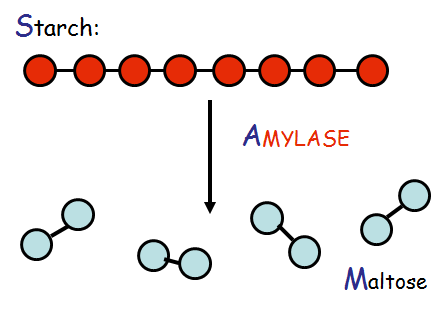Digestion
- Created by: qmfpp
- Created on: 02-05-15 14:46
Overview of the Digestive System
Mouth to Oesophagus
Food enters the mouth. It is chewed and mixed with saliva. This is called mechanical digestion.
Saliva contains amylase, an enzyme that breaks down starch into maltose.
The food then forms a bolus, a ball of food, and is pushed down into the oesophagus.
Oesophagus to Stomach
Once in the oesophagus, the food is pushed down into the stomach by peristalsis. This is the contraction of the circular muscles to push the bolus down.
Stomach
Once the bolus enters the stomach, chemical digestion begins. This is breaking down the food using enzymes (proteins that work as biological catalysts).
The stomach contains hydrochloric acid (HCl), a strong acid, as the enzymes needed to break the food down work best in a low pH. The low pH also kills any microorganisms in the food.
The enzymes used to break down the food are called proteases.They break down the proteins and turn them into amino acids . These can then be used to form new proteins needed in the body.
The Small Intestine - The Duodenum
The partially digested food then enters the duodenum, the first part of the small intestine (SI). Here, bile and more digestive enzymes are added.
Bile is a substance that is produced in the liver and stored in the gall bladder. It is an alkaline solution with a high pH. It has two main functions.
Firstly, it neutralises the pH of the partially digested food. This is because the enzymes that are used work best in alkaline conditions, whereas the food has a low pH from the hydrochloric acid.
Secondly, it emulsifies fat. This means that it breaks up the fat molecules into smaller molecules so that the digestive enzymes have a larger surface area over which they can work.
The digestive enzymes that are in the duodenum are amylase, like in saliva, maltase and lipase. Maltase and amylase are produced in the pancreas and lipase is produced in the SI.
Amylase breaks down starch into maltose - rom a polysaccharide (a long chain of sugar molecules) to a disaccharide (pairs of sugar molecules). Maltase breaks down maltose into glucose - from a disaccharide to a monosaccharide (single sugar molecules).
Lipase breaks down lipids (which have been emulsified by the bile) into fatty acids and glycerol.
The Small Intestine - The Ileum
The fully digested food now enters the second part of the small intesine, the ileum. In the ileum, glucose, fatty acids, glycerol and amino acids are reabsorbed to be used elsewhere.This is called absorption.
The lining of the ileum has a very large surface area, as it contains millions of villi and microvilli. The large surface area allows each absorption of materials.
Each villus absorbs the useful materials through diffusion and active transport. This is made possible as the wall of each villus is only one cell thick. Inside a villus, there is a network of capillaries and a lacteal. The capillaries transport the glucose and amino acids into the blood, and the lacteal transports the fatty acids and glycerol into the lymph (a clear fluid that contains white blood cells). The glucose and amino acids are transportsed to the liver.
The Large Intestine
Once the food has left the small intestine, it enters the large intestine. The large intestine is made up of three parts : the colon, the rectum and the anus.
A lot of water has already been absorbed into the small intestine, however the colon absorbs the rest of the water, as it is useful for other purposes in the body. This leaves faeces, a semi-solid waste material. It contains waste products from the food we eat, bacteria, both living and dead, cells from the lining of the gut, dead red blood cells and indigestible substances such as cellulose, from plant cell walls.
The faeces is stored in the rectum and is expelled by the anus. This is called egestion, NOT excretion. Excretion only involoves fluids.
Related discussions on The Student Room
- Investigation on the effect of bile on fat digestion. »
- Synoptic essay biology A level »
- biology »
- biology aqa alevel proteins question past paper »
- 25 mark essay question »
- Biology essay - importance of proteins in living organisms »
- Semmelweis Entrance Exam 2023 »
- revising for biology the night before year 10 unit 1 »
- Sample digestion method in food testing »
- A level biology AQA »
Comments
No comments have yet been made